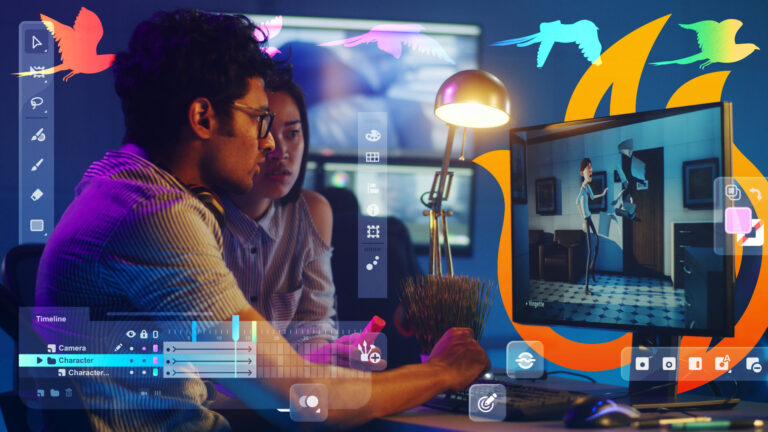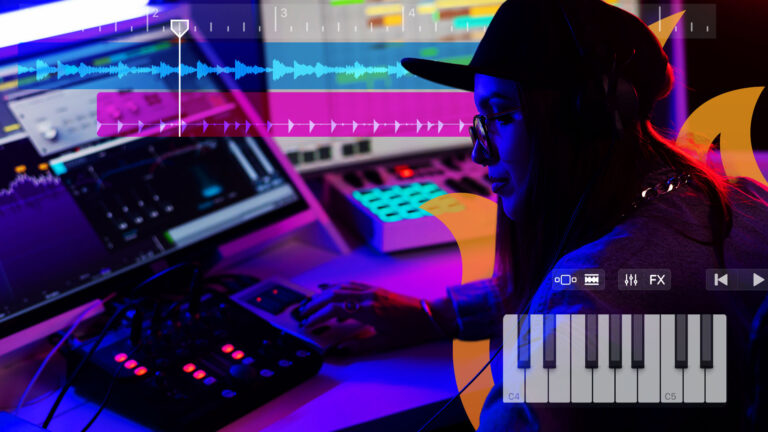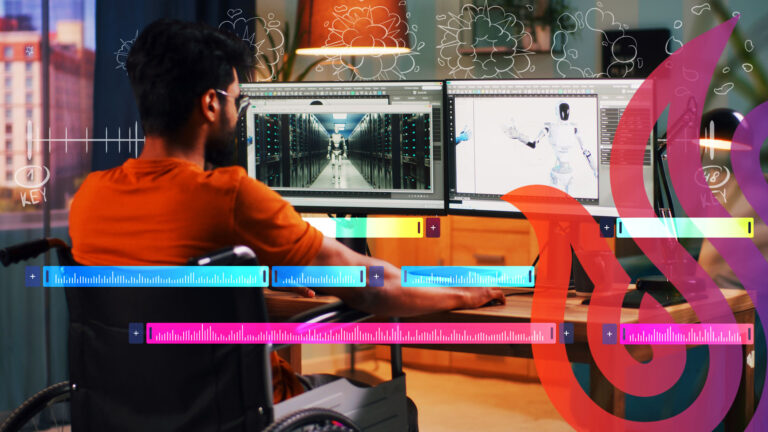The advances in technology and ability to create anything the mind can think of, draws in creators from across the globe. If you have a bold and unique idea, animation may be the perfect medium to bring your story to life. The massive success of cartoons and other 3D animation projects bodes well for any artist who wishes to explore the format.
What is 3D Animation?
The art of 3D animation brings a digital scene to life using motion. As the name implies, each scene simulates 3D space through drawing and rendering techniques. It is similar to drawing a cube on 2D paper. With the proper number of lines and polygons, any flat screen can display believable 3D images.
Since producing 3D digitized assets is quite resource-intensive, special software is used to sculpt digital items and worlds for animations to take place in. Once each object and character are created, an animator breathes life into a scene by making those elements move. The movement of animations are achieved through a process called character rigging.
Rigging a 3D model involves simulating the bone structure and inner workings of a 3D body. For example, the way a human being walks. You have seen millions of humans walk throughout your life and you know exactly how legs are supposed to appear while in motion. Animators must create human characters with a realistic bone structure to emulate the typical movements you are familiar with. While this may seem like a small detail, a substantial portion of the advancement within animation deals with the improvement of these seemingly basic components. As visual fidelity improves, so does the need for increasingly realistic animations.
Many non-humanoid characters and objects are impossible to animate in this manner, as there is no discernible bone structure to base a design upon. This means there are still many 3D animations that must be done “by hand.” While this work no longer involves holding a pencil, the manual nature of drafting these movements caused the term to transfer over from the 2D animation.
What is Motion Graphics?
Motion graphics are digital animations that often rely on text and information to achieve the artist’s intended result. While motion graphics are usually 2D in nature, you can still produce dazzling 3D effects with the medium. Traditional animation is primarily used to entertain an audience. On the other hand, motion graphics are typically used for conveying information or educating an audience. This does not mean that motion graphics fail to entertain. Credit sequences in movies and TV are a notable example of how the art style can entertain and inform all at once.
Since motion graphics are essentially animated graphic design, you will find examples of it throughout the media spectrum. News programs, podcasts, and talk shows all use simple animations to keep viewers engaged. There is so much information vying for your attention that companies hire motion graphics designers to attract your eyes to their stories.
Visual aspects are not the only thing motion graphics animators work on. Most movement of text and numbers is greatly enhanced by the addition of an accompanying sound effect. Think of how video game menus use sound effects when you select various settings. Scrolling, clicking, and movement of any kind is greatly enhanced by audio. Some motion graphics designers spend hours searching for the most satisfying sound clips to bolster the experience. Lyric videos and other examples of typography display the magnitude with which sound enhances graphic design.
What is the Difference Between 3D Animation & Motion Graphics?
The purpose of 3D animation is to create vivid digital scenes full of detail and believability. The characters, objects, and backgrounds must all be carefully considered to produce an entertaining result. Each aspect of a scene must be realized, especially in interactive works where a player has control of the camera angle. 3D animations ultimately tell stories that come in all shapes and sizes.
The purpose of motion graphics is to convey information in a memorable and engaging way. Without movement, sound, and color, many people will quickly forget the information shared in news stories and social media posts. Motion graphics can be entertaining, but it is more accurate to call them stimulating. They grab a viewer’s attention just long enough for the topic of conversation to be understood. While 3D animations can be as long as feature length films, most motion graphics productions are quite small in scope.
What Does a 3D Animator Do?
A 3D animator can be assigned many tasks based on their experience and the role they play at an animation studio. Since 3D worlds have so many components and intricate details to add, large teams are often required to finish them. Each person can be tasked with something extremely specific such as making all the trees sway in the wind. When first starting out, expect to deal with these basic tasks. Animating torchlight may not be the most exciting prospect, but each asset is equally important to create viewer immersion.
Animators with more experience will get to take on major aspects such as the movement of key characters in the story. While every asset is equally important, extra resources are reserved for main characters and scenes that the audience will see most often. You are more likely to notice a weird character walking incorrectly than you are a flickering rock in the background. That is why more experienced animators are tasked with the most crucial animations.
Regardless of your role at an animation studio, you will be immersed in a team environment each step of the way. Learning to communicate effectively, amend disagreements, and work closely with others is a constant focus throughout your career. The good news is that even introverts can still be excellent animators. When you have a common purpose to work towards, conversing with peers becomes much easier.
How Do You Become a 3D Animator?
Everyone’s path to a career in 3D animation will look slightly different. However, there are two distinct options to choose from. You can self-study with online resources, or you can attend a formal education program. While it may be tempting to learn on your own via YouTube tutorials, this approach includes numerous issues that could hinder your chances of getting hired or retaining employment.
The quality of online tutorials varies considerably. For every bit of great advice, you end up sifting through a lot of outdated and incorrect information. Without much experience in the field, you may not know which is which. Applying incorrect information leads to subpar technique that will not impress professionals. Practicing improper techniques only becomes worse as you develop detrimental habits that are hard to shake. Your new animation studio will train you when you first get hired. If you have many bad habits, they will clash with your mentor’s guidance as they expect you to grasp the same fundamentals taught in a digital arts school.
On the other hand, enrolling in a digital arts animation degree program will position you well for your first job in the industry and efficiently build your career. The experienced instructors, up-to-date materials, and insider support enhance your ability to succeed as a professional animator. Here is a breakdown of the numerous benefits of attending a formal education program.
What are the Benefits of Attending a Creative Arts College?
Digital art and animation degree programs plug you directly into the industry you hope to flourish in. These is no better way to kick-start a career than to learn from those with plenty of experience and connections in the field.
Industry Veteran Instructors
When evaluating the quality of a teacher, simply look at the results they have achieved in their craft. The instructors at creative arts colleges have active experience working on animation projects that have been released to the public. Game designers, film animators, and more show you how they brought your favorite animated properties to life. This is a rare opportunity to ask entertainment insiders anything you want to know about professional animation productions.
Evolving Curriculum
Since technology moves quickly in the field of animation, educational materials must evolve to reflect the current landscape. Enrolling in a digital arts degree program gives you access to the latest updates made by the panel of industry experts who curate the curriculum.
Access to Professional-Grade Hardware and Software
3D animation requires specific software applications with the tools necessary to create detailed digital worlds. This complex sandbox requires equally powerful hardware to achieve desirable performance while rendering animation. Professional animation studios have workstation setups that are expensive and out of the price range of most individuals. A creative arts college will have resources for you to tap into from updated versions of the best software to cutting-edge computer processors. There will even be opportunities to explore the new frontier that is VR development.
Growing your Network
While skill and ambition can help you keep a job, getting a job usually requires a pleasant reputation. The entertainment industry hires many animators based on recommendations made by staff members. The more people you know within the industry, the more job offers and leads you will have access to. A fantastic way to earn friends in the world of animation is during a college program. Fellow students have plenty of reason to pay attention to you as you work on projects and learn together. As you develop relationships during school projects, you create connections that may lead to career opportunities down the line.
Career Services
After graduating, you will receive career support from the school referring you to open positions that are a match to your knowledge and passion. A career advisor will ask about your skills and preferences to match you with relevant animation studios. Leverage the school’s extensive industry network to get your foot in the door and start your career today.
Want to Learn More?
If your passion is for visual effects, 2D or 3D animation, or concept art for video games or blockbuster films, this is the Digital Arts & Animation degree program for you. Gain the digital arts and animation skills you need to kick off your career in this dynamic and growing industry.
University of Silicon Valley is uniquely poised to offer a meaningful and valuable education for 21st century students. We believe in an education that directly correlates with the work you’ll be doing after you graduate. Interested in learning more? Contact Us today.


